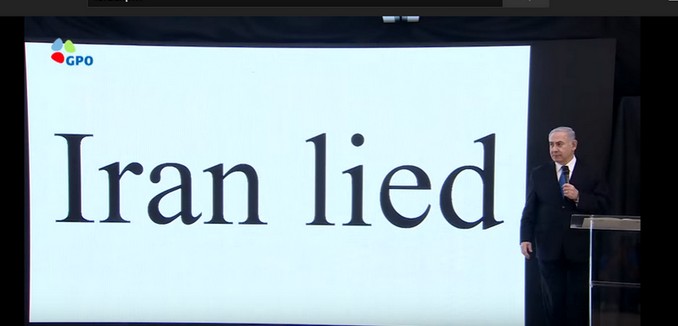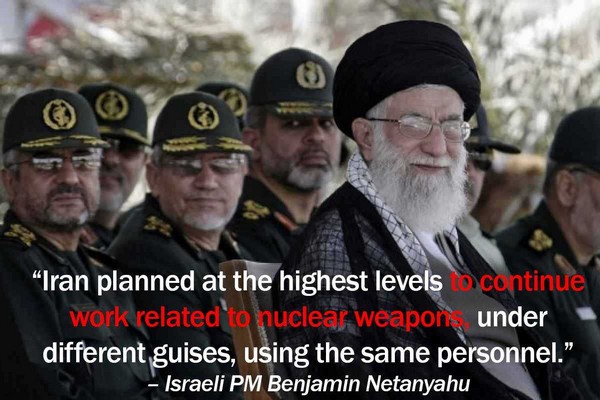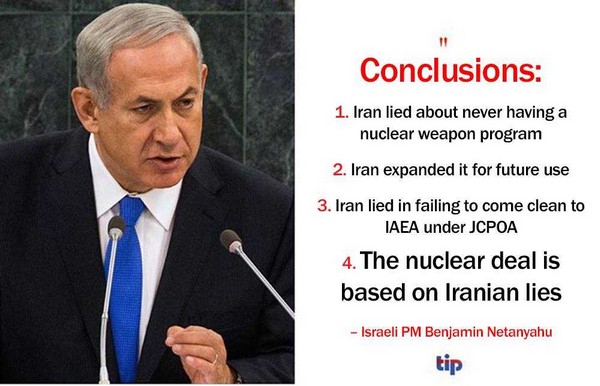On Monday, Israeli Prime Minister Benjamin Netanyahu revealed new dramatic intelligence about Iran’s covert nuclear weapons program, which shows the country is not complying with the JCPOA. Netanyahu displayed excerpts of some 100,000 files Israel recently obtained from a highly-secret compound in Tehran detailing Iran’s long-held nuclear ambitions.
Iran lied about its nuclear program, continued work after deal
•Iran lied about never having a nuclear weapons program. Project Amad, which beginning in the early 1990s put Iran on a path to “design, produce and test… five warheads, each with a 10 kiloton TNT yield, for integration on a missile.”
•Iran lied again in 2015, when the IAEA sought to resolve outstanding concerns about the possible military dimensions of Iran’s nuclear program. The Obama administration and the European Union agreed to lift sanctions over eight years on a network of Iranian scientists, military officers and companies involved in Iran’s secret nuclear program.
•Even after the deal, Iran continued to lie. The Islamic Republic preserved and expanded its nuclear know how for future use, under a different name using the same personnel. Annex I, Section T of the nuclear deal bars Iran from the “development of a nuclear explosive device.” IAEA Director General Yukiya Amano confirmed that he can’t verify Section T of Annex I, in part due to the IAEA’s inability to inspect Iranian military sites.
Iran has the capabilities to become a nuclear threshold state
There are three capabilities Iran must possess to become a threshold nuclear weapons state: enriched uranium, delivery systems, and weaponization. The files obtained by Israel reveal that Iran fulfills these requirements.
•Enriched uranium: Under the terms of this agreement, Iran keeps the right to continue research and development on advanced centrifuges and to begin deploying them in less than a decade. The JCPOA states that Iran’s breakout time is one year, however, were Iran to replace its less-efficient, first generation IR-1 centrifuges with more powerful IR-8s, Tehran could enrich uranium for a weapon much faster.
•Delivery systems: The nuclear agreement did not address Iran’s vast arsenal of ballistic missiles, which U.S. officials believe Iran would use to deliver a nuclear device. Iran already has ballistic missiles that could carry nuclear, chemical or biological warheads 1,500 miles—threatening Israel, America’s Arab allies, parts of Europe as well as U.S. military installments and soldiers in the Middle East.
•Weaponization: Netanyahu’s specific concerns related to Iranian research of nuclear weaponization via warhead research. Under Section T of Annex I, Iran is prohibited from various activities, including “Designing, developing, acquiring, or using computer models to simulate nuclear explosive devices.” The material obtained by Israel prove Iran is in violation.
The fatal flaws of the deal must be fixed
The United States and its European partners must fix the full range of fatal deficiencies in the deal and demand the complete rejection of sunset clauses, robust restrictions on Iran’s ballistic missiles program, wide-ranging limitations on Tehran’s research and development on advanced centrifuges and reliable verification mechanisms.
•The deadline for the President to “nix or fix” the JCPOA is fast approaching on May 12. Cosmetic amendments to airbrush the flaws of the deal will only exacerbate the problem and benefit Iran and Russia.
•The President should reject the fake “new” deal offered by Europe and continue moving forward with imposing sanctions and demanding substantial improvements to the deal, using all available diplomatic and economic tools.
•The administration should continue to work hand in and with Israel and Arab partners to prevent Iran from obtaining nuclear weapons capabilities. Secretary of State Mike Pompeo over the weekend offered strong support to Israel in the standoff with Iran. “The United States is with Israel in this fight and we strongly support Israel’s sovereign right to defend itself,” Pompeo said.






